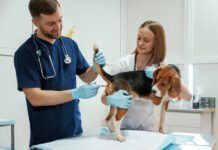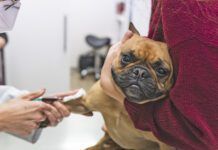It’s not uncommon to come across a lobulated pink or white growth on your dog’s skin, especially if he’s older. These bumps might be on his face, legs, or body. When you touch them, they may feel a bit oily and may even have a slight oily discharge.
These are likely sebaceous adenomas, which are benign tumors of the sebaceous (oil) glands of the skin. They range in size from tiny to about an inch in diameter.
These benign growths are most often found on middle-aged or senior dogs. Cocker Spaniels, Poodles, Miniature Schnauzers, and terrier breeds are most often affected. It’s wise to ask your veterinarian to look at any new growths, of course, but unless they look irritated, red, are bleeding, or are in an area that’s causing the dog to lick or chew at it, it can usually wait till your next visit.
Sebaceous Cysts in Dogs
Sebaceous cysts tend to be singular, smooth, and round. They are white or light pink, like sebaceous adenomas, they also may appear dark or pigmented. They may be found anywhere on the body, but the head is a common site. Some may even form along eyelids, where the eyelash follicles are. Schnauzers are often affected by sebaceous cysts.
These cysts occur near sebaceous glands in the skin, which are full of sebum, an oily substance that helps to lubricate and protect the skin. If a sebaceous gland becomes blocked, a cyst can form. The contained sebum becomes thicker and, if the cyst is opened, the contents are grayish and thick (like toothpaste).
Diagnosing Growths on a Dog
Diagnosis of both types of growth is generally done via observation. If your veterinarian has any concern, she may do a fine-needle aspiration to look at the cells under a microscope. Although rare, removal via biopsy is done with laboratory evaluation by a pathologist.
While both conditions may be unsightly, they usually do not present a serious health problem. If the cyst or adenoma ruptures, secondary bacterial skin infections may occur. Topical treatment such as cleaning with antibacterial solutions or wipes is generally all that is needed.
Removing Skin Bumps on a Dog
Most dogs ignore these cysts and adenomas unless one gets injured. At that point, the dog may lick or chew on the site. (It can be a challenge for groomers to avoid clipping these growths on dogs who have a lot of them.)
If your dog is chewing or licking at any sebaceous cysts or adenomas, you may choose to have them surgically removed. Depending on the size and location of the growth, this might be done by electrocautery, or it might require surgery. Recovery is rapid, but you will need to keep your dog from licking at the healing site.
Preventing Canine Skin Growths
There is no set way to prevent sebaceous cysts and adenomas. Bathing predisposed dogs with an anti-seborrhea shampoo may help, especially for cyst development. Keeping your dog clean and well-groomed may help. Diet has not been shown to be a factor.
Just remember that, while they may be unsightly, these growths are benign, which should be a relief to you!






